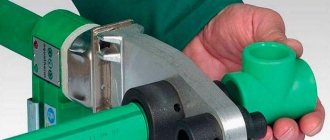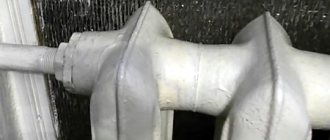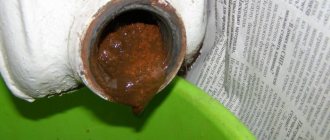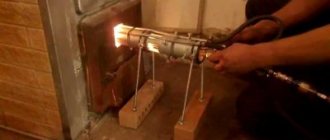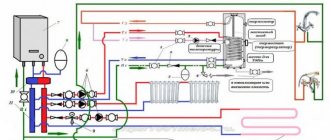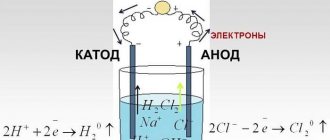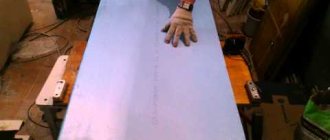Finally overcame laziness and decided to write about soldering the radiator! While there was silence in the blog, to my surprise, the number of subscribers exceeded a hundred! This makes me very happy, so it’s worth continuing to write!
I stopped writing while soldering the radiator. Unfortunately, during this time almost nothing has changed. Work, then a session, periodic repairs of the second car, etc. They didn’t let me deal with the Volga.
Now to the point: the experimental necromancy of radiators bore fruit - I learned how to solder radiators quite well, plus I realized that not everything that can be soldered is worth soldering. Let me remind you that after flushing the radiator with citric acid, it began to leak quite a lot, and therefore, I decided to try to solder it myself. I think it will be more interesting and useful if it is not just a story, but some kind of soldering manual. Fortunately, I have accumulated a lot of experience, and on the Internet, I haven’t seen much description of how this is done.
Tools and materials:
The first and necessary thing is a soldering iron, even two - one - “a la hatchet”, for good heating of large areas, the second - thin, for sealing in hard-to-reach places. A gas blowtorch is also an indispensable thing. Pliers for picking out the “mesh” of the radiator. Well, brushes for the drill for cleaning. At first I tried to use alcohol-rosin flux for soldering; I had it left over from when I soldered a guitar pedal in my adolescence. I really liked it then, but it’s completely unsuitable here. In addition to the fact that it solders poorly, it also leaves layers in the solder through which coolant can leak. So I decided to use soldering acid - it works great. And of course, solder. I used more than 300 grams of it. From the factory, the radiator was sealed with POS 40 brand solder. At first, I also tried soldering with it, but it was very tedious, and the radiator quickly cooled down to a temperature that was not enough for this brand, so I switched to POS 61.
Process: First you need to determine where the leak is. In the worst case, we'll just see a huge hole. The next level, easy leakage, when filling the radiator with water. And finally, when there are no large holes left, the radiator is pressure checked. I did it like this:
An automobile cooling radiator is designed to lower the temperature of the coolant (antifreeze or antifreeze) circulating inside the engine. Its design usually consists of two tanks and honeycombs located between them, which are a system of thin tubes equipped with thin lamellas. Reducing the refrigerant temperature is achieved through natural or forced air blowing of the cells.
Despite its simple design, the radiator sometimes fails. Its main malfunction is a violation of tightness. In other words, it begins to leak. A coolant leak while the power unit is running threatens the latter with critical breakdowns due to overheating.
Replacing a radiator is not so much a troublesome task as it is an expensive one. And the bill here runs into thousands and even tens of thousands of rubles. In this article we will talk about whether it is possible to solder a cooling radiator with your own hands and what tools you will need for this.
Why does a leak appear?
A leak in the device under consideration can occur only for two reasons: due to mechanical damage and due to corrosion processes occurring inside the tubes. In the first case, it may be the impact of a foreign object on the honeycombs or tanks. This usually happens as a result of traffic accidents, hitting a high curb, hitting a stone, etc. Everything is clear here. A visual inspection will allow you to accurately determine the location of the damage, as well as assess the possibility of repair. Corrosion is a little more complicated. In order not to make a mistake and solder the cooling radiator where needed, you will need to carry out a few simple steps to detect the problem area or even areas. The fact is that corrosion damage can occur in several places at the same time.
The main reasons for the loss of radiator tightness, signs, repair features
Loss of tightness of the radiator of the cooling system may be due to the following reasons:
Considering that the sizes of microcracks are small, a strong leak is not observed in this case.
Wet traces of leakage may disappear after cooling the engine and antifreeze. It is advisable to immediately detect the consequences and place of fluid leakage. The sooner repairs are made in this situation, the less damage will have to be repaired. Can be successfully repaired by cold welding .
The resulting crack is usually large in size. It can occur at the junction of plastic and metal radiator elements. In most cases, such damage is difficult to repair.
Depending on the location and size of the damage, cold welding and soldering methods can be used for repairs.
Copper or aluminum
In order to properly solder a cooling radiator, it is necessary to determine exactly what material it is made of. Most often, cooling devices are made from copper and aluminum. It is not difficult to determine the type of material. Copper honeycombs have a characteristic reddish-brown color, aluminum ones – gray.
If you have determined that you have a copper radiator, you can consider yourself lucky. This metal is easy to solder at home. If you get an aluminum device, then you will have to tinker with it, because this material is difficult to solder.
Repairing a copper radiator
To solder an engine cooling radiator made of copper, you will need the following tools and tools:
- powerful soldering iron or gas torch;
- solder;
- soldering flux;
- pliers;
- sandpaper.
First, you need to dry the radiator, especially if you checked it by immersing it in water. Next, the damaged area should be thoroughly cleaned with sandpaper. If there are slats on it, they need to be removed locally. After this, the soldering area is treated with flux and dried again.
You can solder the cooling radiator using either a gas torch or a soldering iron. In the first case, solder is applied in place and heated with a torch until it melts and fills the crack. When using a soldering iron as a heating tool, make sure that it has sufficient power.
If the solder does not adhere to the surface or lags behind, it is necessary to repeat the stripping and fluxing process. You can check the repaired radiator using the method described above.
Using Cold Welding
This method of soldering an engine cooling radiator does not involve heating. The hole is sealed with a special substance that covers the damage. Repairs are performed as follows:
- Prepare the part. To do this, the surface is cleaned of dust and degreased. A rag is moistened with alcohol and the radiator is gently wiped with it. You can’t apply any force; the metal will be damaged even more.
- Prepare the adhesive composition. It is selected according to the type of metal. Cold welding is a thick mixture that must be evenly distributed over the defect. Careful application improves the quality of the seam. Wait for the composition to dry and inspect the soldered radiator.
What is the difficulty of soldering aluminum?
Aluminum is a very specific metal. Its peculiarity lies in its high chemical activity, manifested in the formation of a so-called oxide film on the surface. It appears instantly when pure metal comes into contact with air, reacting with oxygen. And it is precisely because of this that it is impossible to solder an aluminum cooling radiator in the usual way. This will require additional substances that contribute to:
- removing oxide film from the surface;
- reducing surface tension;
- protection from adverse factors affecting the soldering process;
- improved solder flow.
Materials and tools for soldering aluminum radiators
In order to solder a cooling radiator, the honeycombs of which are made of aluminum, you will need:
- powerful soldering iron;
- solder (tin-lead or tin-bismuth alloy);
- iron filings;
- rosin;
- fireproof container (crucible).
It is desirable that the soldering iron has a power of more than 100 W. Otherwise, it simply will not be able to warm up the aluminum. As for solder, a tin-lead alloy is suitable for sealing small cracks (holes). If the damage is significant, then it is advisable to use solder consisting of 5 parts bismuth and 95 parts tin. Such an alloy can be easily purchased in stores that sell radio components. Usually, it has the form of wire and is marked as POSV-33 or POSV-50.
Metal soldering
The method of repair at home is chosen in accordance with the material used to make the car assembly.
Copper radiators
To weld a part with your own hands, perform the following steps:
- Prepare surfaces by cleaning them from dust and grease. Place the copper radiator on a hard horizontal surface.
- Warm up the area to be treated with a hair dryer. This gives the metal softness and ductility.
- Apply a thin layer of liquid rosin to the leak site. Without allowing the material to cool, the required amount of solder is applied on top. It is distributed over the damaged area using a heated soldering iron. Rosin ensures good adhesion of the filler material to the base.
Features of working with aluminum
An oxide coating appears on the surface of any product made from this metal, which is destroyed at high temperatures. Until the film dissolves, it will not be possible to solder the aluminum elements. To repair holes in a radiator made of aluminum, the following tools and materials are used:
- soldering iron with a power of more than 100 W;
- metal filings;
- rosin;
- tin-lead solder.
To eliminate a leak, carry out the following actions:
- Dismantle the radiator and drain the coolant. Clean the internal surfaces from scale using a special product. The solution is poured into the cavity of the part, after some time it is removed along with the dissolved contaminants.
- Clean and degrease external surfaces. Dry the element with a hair dryer. Before soldering the radiator, remove the oxide deposits mechanically using a file or an iron brush. If this is not done, the quality of the seam will be poor.
- Mix rosin with steel filings and apply the composition to the repaired areas of the aluminum radiator. Using a heated soldering iron tip, apply solder evenly.
Brass radiator repair
The process of sealing a part made of this material is practically no different from repairing copper elements. Before starting work, surfaces are cleaned of dirt and degreased. An industrial hair dryer is used to warm up.
Damaged areas are treated with soldering acid, evenly distributing it with a brush. POS-40 solder, which has a high melting point, is used for welding a brass radiator.
When working with this metal, 2 types of flux are used:
- For 2 parts of powdered rosin take 1 part of steel filings. They are mined by rubbing a file against a metal surface. The components are placed in a container made of refractory material, heated with a burner, mixed, and cooled.
- 10% cryolite, 56% KCl, 7% NaCl, 4% Na2SO4 and 23% LiCl. All components are crushed and mixed. The flux is stored in a dark place in a closed container.
We recommend reading: How to solder polypropylene pipes
An electric device for soldering brass will not work. It is replaced with a soldering iron heated in an oven. Solder is delivered by feeding a tin rod.
Preparing gumboil
Soldering a cooling radiator with your own hands is only possible if you have high-quality flux. You will have to prepare it yourself. And it’s better to do this just before you start soldering. So, pour 2 parts of ordinary rosin and 1 part of iron filings into a fireproof container. Sawdust can be made using a file with fine notches, processing any iron workpiece that comes to hand. Heat the resulting mixture over a fire, stir and let cool. That's basically it. Flux for aluminum is ready.
Flux for the most durable seam
To obtain the most durable protective seam at the site of damage to the radiator, a special flux called flux is used. It can also be obtained at home. To prepare flux, you will need the following substances in the following proportions:
- potassium chloride – 56%;
- lithium chloride – 23%;
- cryolite – 10%;
- coarse table salt – 7%;
- sodium sulfate – 4%.
The ingredients are finely chopped and mixed. This melt must be stored in a hermetically sealed glass container in a dark place.
We repair an aluminum radiator with our own hands
The radiator, as in the previous case, is washed and dried. We thoroughly clean the soldering area with emery cloth and then degrease it. After this, we apply pre-prepared flux to it using a soldering iron. Rub it thoroughly over the surface. Next, we apply solder layer by layer, stretching it over the surface to be repaired. The role of the iron filings is to destroy the oxide film at the very last moment before soldering, thereby allowing the aluminum and solder to bond.
Radiator repair: Soldering irons out! — Autocentre.ua
Mid-autumn is the last time to tidy up the cooling system before adding fresh antifreeze. Known, by the way, not only for its frost resistance, but also for its ability to seep even through microscopic cracks. And then, as luck would have it, the radiator leaked...
| Brass radiator soldering technology |
| Mid-autumn is the last time to tidy up the cooling system before adding fresh antifreeze. Known, by the way, not only for its frost resistance, but also for its ability to seep even through microscopic cracks. And then, as luck would have it, the radiator leaked... |
This is what they teach in school
According to plumbing textbooks, soldering is the process of creating a permanent connection of parts using a special alloy (solder). Unlike another popular method - welding, when soldering the metals being joined do not melt, only the solder melts, which wets both parts and fills the gap between them.
After cooling and crystallization, the solder, adhering to both surfaces, like glue, securely binds them. Strength depends on the cleanliness of the surfaces and heating (it is important to melt the solder, heat the parts and maintain the required temperature for a certain time).
The characteristics of the selected solder and flux, as well as the properties of the materials of the parts being repaired, are important.
Soldering iron is half the success
In most cases, to solder a radiator you need a massive soldering iron with a power of at least 100 W. But a damaged tube can be soldered with a regular 60-watt one. Much depends on how efficiently the soldering iron transfers its temperature to the part. This, in turn, is due to the correct tinning of the tip, the presence of a sufficient amount of solder at the point of contact of the tip with the part, and the angle at which you hold the soldering iron relative to the surface being repaired.
In addition to electric ones, soldering irons heated over an open fire are also used. There is no fundamental difference in their use, except that during the soldering process it is necessary to additionally control the heating and cooling of the working part of the tool.
Safety precautions
| The electric soldering iron must have intact cord insulation and a working plug. During operation, make sure that the cord does not touch the tool or heated parts. |
| Hold the soldering iron by the handle only. You cannot determine its heating by touch - just hold your hand at some distance from the sting. |
| Vapors from heated solder and fluxes are harmful to health. Work should be carried out in a ventilated area or in the fresh air. |
| Please note that the solder takes a long time to cool down on a heated part, so after removing the soldering iron, do not rush to immediately touch the seam with your hands. |
How to solder plastic on a cooling radiator
Most modern car radiators have tanks made of heat-resistant plastic. This material does not react with coolant and does not corrode, but it does not have the elasticity to withstand mechanical damage. That is why some car owners, faced with the problem of a broken tank, are wondering whether it is possible to solder a cooling radiator whose plastic has been damaged. Can! But it is better to entrust this matter to professionals. Heat-resistant plastic is very difficult to solder due to its rigidity. Yes, and choosing the right material for this is quite difficult.
Today you can find hundreds of offers from organizations and individuals who are ready to solder a cooling radiator with high quality. The price for such services ranges from 100 rubles per sq. cm. You will have to pay separately for removal, diagnostics and installation of the device.
If the issue of repairing the tank has become very acute, or you don’t really want to pay, you can try to do it yourself. To do this, the damaged area must be cleaned and formed in such a way that the material that will be applied as a restorer can easily penetrate into the gap. Next, the treated area is degreased.
As for the gluing material, it can be soft plastic or two-component epoxy adhesive. In the first case, the plastic is melted using a soldering iron and applied to the damaged area with a small spatula. The glue is applied in the same way. When performing work on soldering tanks, it is advisable to use a reinforcing mesh with small cells. It is placed between layers of adhesive material. Of course, such soldering cannot guarantee years of trouble-free operation of the radiator, but it is quite suitable as a temporary measure.
When a car radiator starts to leak, not all car owners have the opportunity to immediately replace it with a new one. For some models, a car radiator costs tens of thousands of rubles, for others you have to wait for more than one week for its delivery. Soldering the cooling radiators can help hold out until replacement. The soldering method depends on the material from which the heat exchanger is made.
The main causes of damage to a car radiator
Being in a risk zone, a car radiator takes on more than just a headwind. Often, stones, branches, rubble and even birds can damage the radiator. The driver should occasionally inspect its surface for damage. This will make it possible to identify problems at an early stage and take measures to eliminate them.
The following are the causes of damage to a car radiator:
1.Mechanical
Any damage associated with a violation of the integrity and tightness of the radiator. Even a stone flying from under the wheels of oncoming traffic is enough to damage the radiator. As a rule, head-on collisions with other cars or real objects come first.
2.Repair
They can also be classified as mechanical damage, but in this case, the reason for the violation of the integrity of the radiator is inept handling of the tool when repairing the car.
Often car repairs require dismantling the radiator. Many mechanics, when carelessly handling this important element of the cooling system, damage it with tools.
3.Corrosion
Damage to the radiator that seems insignificant at first glance in the form of scratches and chips can develop into active foci of corrosion. After some time, if the process is started, damage may form through which antifreeze or antifreeze begins to slowly leak out. It is difficult to notice them, but nevertheless, a meticulous examination of the radiator will help to detect them.
In principle, these are the main reasons that can cause damage to the surface of the radiator and compromise its integrity. There are still some operational problems regarding its use that disrupt the normal circulation of coolant.
Why does a leak appear?
The main reasons leading to antifreeze leakage from the cooling system through the heat exchanger are the following:
- mechanical destruction of tubes or collector tanks during an accident;
- thermal destruction of joints due to overheating and operation without liquid;
- corrosion damage.
The first two reasons are somewhat easier to repair because, as a rule, the location of the damage is easy to determine.
In case of corrosion damage, the location of the leak will have to be located. Moreover, it may not be the only one.
Security measures
When repairing a car radiator, you should be extremely careful and follow certain safety measures. The heat exchanger itself must be disconnected. Drain all liquid completely.
If you have not previously had experience working with a soldering iron, it is better to entrust this task to professionals. In this case, you should at least practice on less important surfaces and parts of the car.
When working with cold welding or glue, it is important to use gloves to avoid damaging your hands. In addition, be sure to follow the instructions for using the glue. This way you can not only achieve the ideal effect of the repair, but also protect your hands from the harmful effects of adhesives.
Looking for a leak
If a stain of antifreeze remains under the car after parking, it means there is a leak in the cooling system..
Before removing the cooling radiator or air conditioner, you should make sure that all pipes and the expansion tank housing are in order. The heat exchanger of the interior heating system is also checked.
Before dismantling, you need to drain the liquid from the system . The removed radiator is carefully inspected in good lighting. If the damage cannot be seen, all holes are plugged with tight plugs and the heat exchanger is immersed in water. The emerging chain of bubbles will indicate the location of the leak. If you increase the pressure by connecting one of the pipes to the compressor hose, you can detect a leak faster.
How to find a leak in the cooling system
Cooling system malfunctions are identified during vehicle maintenance and repair.
To identify damage, the radiator is removed from its installation site. Through a special hole, the coolant is drained into a pre-prepared container. To drain the coolant, the device is turned over and shaken several times.
There are two main methods used to detect leaks:
The visual method consists of identifying damage during inspection of units. The location of the leak is determined by characteristic marks on the grille or other elements of the cooling system.
The instrumental method is carried out using various diagnostic equipment. When a leak is detected, the equipment emits a light and sound signal.
Copper or aluminum?
For high-quality soldering of faulty car radiators, you need to find out what they are made of. Modern devices are made of aluminum, copper or plastic.
The easiest way to distinguish material is by color:
- copper: red-brown;
- aluminum: grayish shades.
The plastic used for radiators is usually black.
Copper is quite easy to solder in a home workshop or garage . Soldering leaky aluminum car radiators is complicated by a number of its physical and chemical features.
We repair the radiator
Soldering copper radiators will require preparing the following:
- high-power electric soldering iron or gas burner;
- correctly selected solder;
- flux paste;
- abrasive paper;
- pliers;
- degreasing solvent;
- rags.
At the preparation stage, the product is cleaned of mechanical impurities and thoroughly dried. To speed up drying, you can blow it through one of the nozzles with compressed air under low pressure. The leak area is cleaned with abrasive paper. If there are lamellas nearby, they are carefully trimmed. Flux compound is applied to the soldering area and allowed to dry.
Determining the location of damage
Car radiators are at greatest risk of damage, as they operate in temperatures with different signs and under the influence of strong vibrations.
Cases of mechanical damage to such devices cannot be excluded. Radiators of air conditioners, which are used as condensers and evaporators, are less often repaired. But such cases also happen. It’s very unpleasant when the climate control suddenly stops working in a luxury car during the hot season.
One of the most effective and affordable repair methods is soldering radiators. If a car radiator is damaged, it is very important to promptly identify the problem and try to fix it.
The auto radiator, which is part of the engine cooling system, is a very important component. Structurally, this device consists of two vertical tanks connected by a large number of thin horizontal tubes. The coolant circulating in them releases heat into the air through natural heat exchange and cools down. To improve heat transfer, the surfaces of the tubes in contact with the surrounding air are increased. To do this, thin metal plates - fins - are soldered to them.
Signs of damage to the radiator are an increase in engine temperature during operation, as well as a decrease in the coolant level. Of course, fluid loss can occur not only through the radiator, but most often the cause is this particular unit. Visually, major damage can be determined by observing the coolant leak. But it will be quite difficult to do this on a hot engine, since the antifreeze will immediately evaporate. Some compositions are painted with special pigments that remain on the surface of the part after drying, which helps to identify the location of damage.
If it is determined that the leak occurred in the radiator, but no damage is visible, it is necessary to remove the device from the car, first draining the coolant. After this, you need to close all the holes, leaving one, and supply air under slight pressure into it, lowering the radiator into a container of water. The location of the hole can be determined by the escaping air bubbles.
Preparing gumboil
To repair a heat exchanger with your own hands, you should take care of a good flux composition. Flux is prepared shortly before soldering a leaky radiator, since over time the composition decomposes and loses its properties. For two shares of crushed rosin you need to take one share of steel filings obtained using a file .
The composition must be poured into a fireproof container, mixed and heated with a burner. Then stir again and cool.
For the most durable seam
There is another recipe for flux, which is commonly called “flux”. With its help, you can achieve special seam strength. To create the flux you will need the following ingredients:
All components should be crushed and mixed thoroughly. The composition should be stored in a tightly closed container, protected from light.
Soldering order
Proper organization of the aluminum soldering procedure requires thorough preparation, without which it will not be possible to achieve the desired result. Before soldering the radiator yourself, you should carefully read the relevant instructions. It states that the preparatory stage includes cleaning the area to be restored and preparing a soldering composition of the required quality.
Preparatory operations
Before starting soldering, it is necessary to remove the old coating and clean the soldering area
Before soldering an aluminum radiator using rosin-based flux, the damaged area is prepared according to the following instructions:
- Remains of the old coating and traces of contamination are removed.
- The soldering area is cleaned using abrasive.
- Immediately after this, it is degreased with a solvent.
Before soldering the radiator, you will need to prepare the flux in a metal crucible in advance. To do this, rosin is first melted with a gas burner, after which small iron filings, taken in a ratio of 1:2, are added to the melt (they act as an abrasive). At the same time, the prepared composition is mixed until it becomes a homogeneous mass.
Elimination of small defects
Upon completion of the preparatory operations, proceed to the soldering process itself:
The soldering iron picks up a small amount of solder. Using circular smooth movements, it is applied to the area previously treated with flux. During the processing process, it is important to carefully ensure that the layer of solder is distributed over the surface as evenly as possible.
When soldering, the sawdust contained in the solder removes oxides from the surface, and the previously added rosin blocks the oxygen access channel. As a result, all conditions are created to obtain reliable contact between different metals. This method is only suitable for small damage, the size of which does not exceed a few millimeters. On large areas, the flux cools quickly and does not provide good heating of the soldering area.
Restoring significant damage
To restore a significant area of the radiator, you will need a special composition - flux
The need to restore large-area aluminum surfaces is encountered quite often. You will need a special soldering compound called “flux”. Before using it, the battery surface to be treated is prepared, as was done for small areas.
Initial components for preparing flux:
- potassium and lithium chlorides;
- regular table salt;
- sodium sulfate;
- cryolite.
The mixture prepared in a certain proportion is first thoroughly ground in a mortar to a powder state. After this, it is poured into a crucible, where it is thoroughly mixed until a homogeneous mass is suitable for obtaining a melt.
Soldering procedure using flux:
- The damaged area is thoroughly heated using a gas burner.
- A thin layer of flux is applied to the prepared area.
- The damage is soldered with tin-lead solder with the addition of small amounts of bismuth.
When working with special equipment (gas burner), it is important not to overheat the area being restored, so as not to burn it. The strength of the flame is selected so that it is only sufficient to uniformly heat the surface of the aluminum product
Repair of complex configuration radiators
Soldering a car radiator
There may be situations when it is necessary to restore (unsolder) an aluminum car radiator that has many hard-to-reach places. In this case, methods based on the use of iron rosin flux and home-made flux are not suitable. Thin-walled tubes of a copper or brass car radiator, for example, are very difficult to solder due to the design features. In this situation, it is recommended to use low-temperature solder (LTS) with simultaneous gluing of the surface to be restored. To the list of preparatory operations considered, we should add the need to crimp the damaged area of the radiator or stove with pliers, which will reduce the size of the hole.
During soldering, the area to be treated is first thoroughly heated with a gas burner, after which an NTP rod is introduced into its flame. By periodically moving it over this place, you need to try to make sure that the solder particles cling to the edges of the damage and gradually “tighten” it. At the final stage, you will need to seal the defect area using a special high-temperature glue. With its help, it is possible to “fix” all the remaining minor irregularities and flaws.
We straighten aluminum with our own hands
Soldering aluminum radiators requires careful preparation of the repair site.
The faulty unit should be washed and dried completely. The repair area must be cleaned with abrasive paper and degreased with a rag moistened with a solvent.
Now you can apply a layer of flux with a soldering iron and rub it over the part. Next, solder is applied. Do this in several layers, rubbing and stretching each one. The steel filings contained in the flux will react with the oxide layer and destroy it. This will allow the solder to be in direct contact with the surface of the part and will significantly improve the quality of soldering.
After repair, it is necessary to re-check the radiator for leaks
Welding as a method of radiator repair
At home, it is difficult to use welding to repair radiators. This requires special skills and special welding equipment. Otherwise, the thin metal of the walls will burn through, and instead of being repaired, the radiator may become completely unusable.
Cold welding
Cold welding refers to the joining of materials using a special glue. Usually this is a two-component adhesive based on mastics, epoxy compounds, metal powders to strengthen the structure of the joint, and additives.
The technological process for repairing radiators for almost all types of cold welding is approximately the same. The repair area is first cleaned with solvent and sandpaper. Then the glue components are thoroughly mixed (the mastic is kneaded). After this, the composition is applied to the repair site and left in a warm place.
To increase the reliability of cold welding, extensive repairs are usually performed. To do this, limit the leakage of glue from adjacent areas and from the back surface of the radiator. A kind of “bowl” is created into which glue is poured. This allows you to increase the reliability of the connection. Thermal expansion blocks antifreeze leakage.
A special feature of operating a vehicle after cold welding is the need for periodic monitoring of the repair site for a month. During operation, the radiator is subjected to large mechanical, thermal, and chemical loads. The bonding site may collapse, crack, and undesirable chemical reactions may occur there.
The radiator is primarily responsible for cooling the engine. Its serviceability is an indispensable condition for the performance of the engine.
Did you like the article? Share on social media networks:
Source
How to solder plastic?
On modern cars, to reduce overall weight and reduce production costs, many parts are made of plastic. Radiators did not escape this fate either. First of all, it is necessary to accurately determine the type of plastic . This is done according to the markings on the part. As a rule, polyamide (PA marking) or polypropylene (PP marking) is used for manufacturing. It is with this marking that you need to purchase welding rods for plastic. They can be replaced with strips cut from an unnecessary plastic part with similar markings.
The following materials and equipment will be required:
- industrial hair dryer for heating the workpiece;
- electric soldering iron with adjustable tip temperature;
- solder selected in accordance with the radiator material;
- acetone;
- rags.
You must act in the following order:
- degrease the damaged area with a rag soaked in acetone;
- warm up the repair area with a hairdryer;
- set the soldering iron temperature to 250 o C;
- move the soldering iron tip along the seam line several times so that a recess is formed in the shape of the welding rod;
- insert the rod into the recess and, smoothing it with a soldering iron, level it flush with the radiator body.
During soldering, you need to ensure that the plastic softens, but does not melt or burn. After the repair and before installing it back on the vehicle, you should check the tightness of the repaired area in a container of water.
General rules for installing radiators
The battery is attached to the wall with special brackets.
It can be installed openly, which is most optimal, recessed into a niche or covered with decorative finishing elements. When deciding how to properly install an aluminum heating radiator, you need to take into account that when closing the heat source, a loss of up to 30% of power is possible. Having made this choice, it is better to lengthen the heating devices through additional sections. Any connection method will use three of the four radiator holes. Close the unused channel with a plug.
The two connection points to the system will act as input and output. On the third, always the top one, you need to connect the Mayevsky valve, through which air is removed after filling the system with coolant.
According to the design standards establishing how to correctly determine the connection location of an aluminum heating radiator, the following dimensions must be maintained:
- There should be a free space of at least 10 cm between the top of the radiator and the window sill. If the distance is made smaller, the rising warm air will heat the window sill rather than heat the room.
- The gap between the floor and the heater should not exceed 12 cm. As this gap increases, the heating of the lower part of the room deteriorates.
- You need to retreat from the wall to a distance exceeding 2 cm. At a shorter distance, the free upward flow of warm air masses behind the sections is impossible, as a result, thermal energy will go into the wall.
Often people, without thinking about where and how to properly connect a heating radiator in an apartment or other room, reduce the efficiency of this device. In this case, losses will account for a considerable part of the precious heat.
- Installation under an element protruding from the wall by 3 - 5 cm - about 4%.
- Placement in an open niche - up to 7%.
- Partially closing with a grill - up to 15%.
- By installing the grill over the entire area of the heated parts - up to 30%.
For lateral and diagonal connections, it is better to arrange the entrance through the top channel. When the coolant is supplied from below, the heating efficiency decreases by up to 15%.
The top plane of the battery must be in a horizontal position.
Trying to follow the conditions for how to most correctly and conveniently connect heating radiators, do not forget to use a supply tap that has a digital or dot scale on the adjustment handle. The presence of this option will allow you to easily set the amount of incoming liquid.
When assembling the connections of the coolant supply and discharge pipelines with outlets to the radiator and at the connection points of heating kits, taps should be used that allow you to disconnect the battery from the system if it is necessary to repair or replace it. This mechanism is called “American”.
The laying of pipes connecting the radiator to the system is carried out after installing the sections.
When choosing how to properly connect heating radiators, we will consider each combination of the type of system and method of connecting the heaters.

